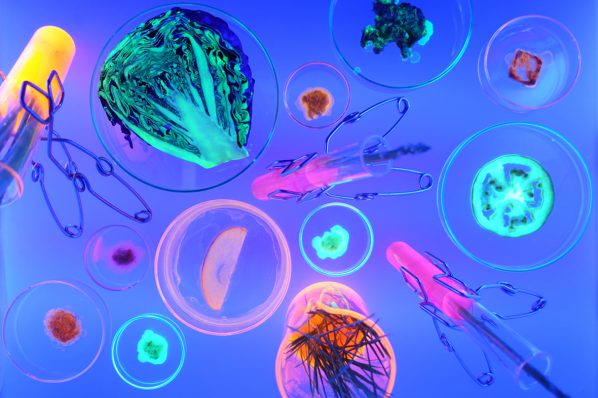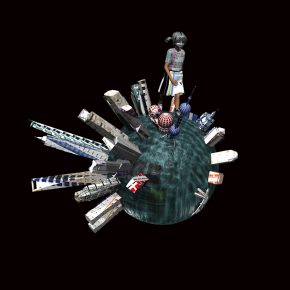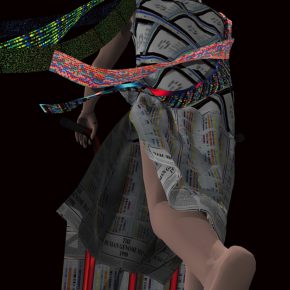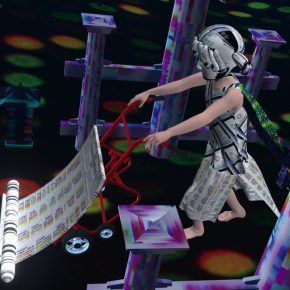
Classical humanist thought begins from the womb, conceptualizing it as a magical incubator of brilliance. We emerge from this warm and nurturing environment as stand-alone self-sufficient entities — little geniuses and wunderkinds in comparison to our “animal friends”. The posthuman reality, however, is much more complicated. The maternal umbilical cord is cut, and in its place grow new “lifelines” of information systems and technology which ensure the survival or our species. Wu Tzu-ning’s solo project “Born Beyond the Womb” takes us on a journey through the cyber-scape and into transhumanist topics, the murky depths of genetic engineering and the digital afterlife. The show is divided into three sections: posthuman skins, posthuman memories, and posthuman implants. Using video, websites, and installations, it addresses topics such as our networked existence, genetic engineering, vertical farming, genetically modified food, and infusion based feeding systems. This exhibition is part of the larger series “Foreign Bodies: Human Identity in a Posthuman World” organized by the Department for Culture and Education of the German Consulate General in Shanghai (AKuB).
Posthuman Skins
This first section of the exhibition looks at the concept of skin in terms of web interface and the experience of the internet as a series surfaces with “Cyber Native — Shanghai Planet” — a 3d animation video work. In it, we see a young girl marching around a globe which spins like the ball inside a mouse, moving erratically in the manner of internet navigation. The globe is covered in a wallpaper of internet screen shots, over which turquoise, simulated waves gently ripple. Architectural landmarks of Shanghai stand knee-deep in the water, their facades composed of constantly rotating screen-shots. The “Cyber-native” herself is also clad in screen-shot wallpaper and marches around the globe to the tune of an off-key 8-bit soundtrack reminiscent of early gaming audio tracks. “Cyber Native — Shanghai Planet” functions as a kind of off-kilter role player game, full of constantly shifting surfaces and no clear direction.
Posthuman Memories
“Cyber Samsara” uses this same approach of skins and surfaces but this time the wallpaper is a collage of different sources, chromosomal maps, aboriginal patterns from Taiwan and sequences of nucleotides from the National Center for Biotechnology Information — a visual database of plant and animal genomes. Here Wu uses the term “memory” as a “carrier of material, biological, and protein forms”, thus exploring the connection between disembodied information of the genome and the embodied flesh of the human.
The video takes its script from the concept of “fortune vending machines” playing folk beliefs off of the scientifically predictable outcomes provided by genetic engineering. While the typical vending machine will send a distinguished Taoist sage to deliver one’s fortune in a ceremonial manner, in Wu’s video, the “Cybernative” marches through a temple courtyard with a push cart to deliver a chromosome which drops off the edge of the cart into an abyss. Wu has also produced an APP version of the work which viewers can interact with, calling up a fortune and receiving a chromosome in return. Viewers do not control whether they are embodied as a plant animal, or human — but in any case, genetic difference between these organisms is, in fact, extremely minute. Posthumanists would generally favor this “species cosmopolitanism” — a view that places each species as an equally important node in a continuum of evolution where the commonalities between species act to mute human exceptionalism.
Posthuman Implants
The success of humans as a species has increased the strain on the earth’s ecosystems, so much so that we find ourselves searching for technological solutions to problems which were created by technology in the first place. In this section of the exhibition, Wu looks to future food production and delivery systems — a future which radically alters what it means to grow, cook and eat food. In the videos “Toxic Future” and “Plant Factory”, she examines how contaminated soil leads to the growth of vertical farming where mud-caked overalls are replaced by “clean suits” and hermetically sealed environments in a Taiwan hydroponic indoor farm. The video “GFP Lab,” takes this process a step further with laboratory-generated food grown in Petri dishes with luminescent liquids to highlight the contradictions between technological solutions and culinary culture something which echoes much of the controversy surrounding things such as “cultured meat” which is now only a few years from going to market.
Then, as if completing the circle, Wu returns to the womb as a hermetically sealed loop of its own. “GFP self-cultivating Instructions”, envisions a world where are we are nourished by artificial wombs which produce food for human consumption — thus eliminating all worries of food supply chain safety. “GFP self-cultivating Instructions” uses the language of marketing as a mock commercial for “GFP Good Food Provider” — a system whereby one attaches a “kit” to cultivate food within the same metabolic system. Moving through plastic tubing, nutrients travel the reverse direction from the womb into a crystalized piece of food consumed by the individual. As this umbilical cord sucks food out of the womb, we see the words “Have peace of mind as you consume yourself” flashing across the screen, in an echo of Lu Xun’s “Diary of a Madman”.
Reflecting our deep-seated angst towards technology, “Born Beyond the Womb” aims to help us navigate this complicated relationship between humans, networks, and machines. Katherine Hayles points out that though many of these imagined futures point to the dystopic, “We can craft others that will be conducive to the long-range survival of humans and of the other life-forms, biological and artificial, with whom we share the planet and ourselves.”
About the exhibition
Born Beyond the Womb: Wu Tzu-ning Solo Exhibition
Part of the Project: “Foreign Bodies: Human Identity in a Posthuman World”
Dates: December 16, 2016–January 13, 2017
Opening and Artist Talk: December 16, 2016, 6:30-9:00
Venue: Department for Culture and Education of the German Consulate General in Shanghai (AKuB)
Curated by Rebecca CatchingLocation: Department for Culture and Education of the German Consulate General in Shanghai (AKuB) 101 Cross Tower, 318 Fuzhou Lu, near Shandong Zhong Lu, Huangpu, Shanghai





































